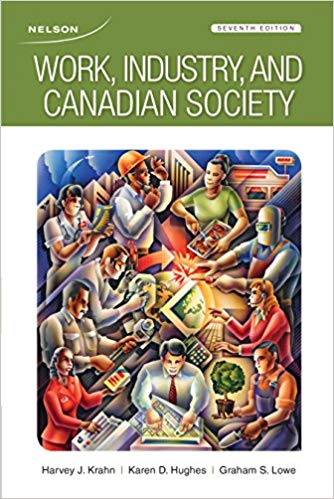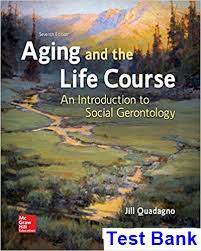Work Industry And Canadian Society 7th Edition By Harvey J. Krahn – Test Bank
Original price was: $55.00.$19.00Current price is: $19.00.
Digital item No Waiting Time Instant Download
ISBN-10: 0176531939 ISBN-13: 978-0176531935
Book Name: Work, Industry, and Canadian Society
Edition: 7th Edition
Publisher : Nelson College (January 1, 2014)
Author name: Harvey J. Krahn, Karen D. Hughes, Graham S. Lowe
Description
Work Industry And Canadian Society 7th Edition By Harvey J. Krahn – Test Bank
TABLE OF CONTENTS
Chapter 1: Historical Perspectives on Work (1700–1950s) 1-1
Chapter 2: Contemporary Debates on Work (1950s to Present Day) 2-1
Chapter 3: Canadian Employment Trends 3-1
Chapter 4: Good Jobs, Bad Jobs, No Jobs 4-1
Chapter 5: Labour Markets: Opportunities and Inequality 5-1
Chapter 6: Gender and Paid Employment 6-1
Chapter 7: Household, Family, and Caring Work 7-1
Chapter 8: Organizing and Managing Work 8-1
Chapter 9: In Search of New Managerial Paradigms 9-1
Chapter 10: Conflict and Control in the Workplace 10-1
Chapter 11: Unions and Industrial Relations 11-1
Chapter 12: Alternative Approaches to Economic Organization 12-1
Chapter 13: Work Values and Work Orientations 13-1
Chapter 14: Job Satisfaction, Alienation, and Work-Related Stress 14-1
Chapter 3: Canadian Employment Trends
Multiple-Choice Questions
Identify the choice that best answers the question.
1. Which of the following would most likely be true if you had entered the Canadian paid labour force in 1901 rather than 2011?
a. You would have been more likely to work in the service sector.
b. Your chances of becoming a manager would have been greater.
c. Your sister would have been more likely to be joining you in the paid labour force.
d. You probably would have found work in a smaller organization.
ANS: D PTS: 1 REF: Chapters 2 & 3 BLM: Higher Order
2. From which of the following sources are monthly unemployment rates obtained?
a. The national census.
b. The Labour Force Survey.
c. A monthly survey of employers, asking if they have had difficulty hiring workers.
d. The National Household Survey.
ANS: B PTS: 1 REF: p. 59 BLM: Remember
3. Which of the following is correct about the age distribution of Canada’s population?
a. It has remained much the same for the past several decades.
b. Over one-third of Canadians today are age 65 and older.
c. The age profile of the working age population is not a good fit with the decision-making and authority structure of most work organizations.
d. Immigrants tend to be older than Canadian-born citizens.
ANS: C PTS: 1 REF: pp. 60–64 BLM: Higher Order
4. Demographic studies in Canada highlight which of the following?
a. Visible minorities now make up half of the population.
b. Seniors (age 65 and older) now make up one-third of the population.
c. For the past 25 years, the majority of immigrants to Canada have come from Asia.
d. Canada’s Aboriginal population is as large as the visible minority population.
ANS: C PTS: 1 REF: p. 63 BLM: Higher Order
5. Which of the following statements best exemplifies recent immigration trends in Canada?
a. Compared to the 1990s, most immigrants come to Canada from African countries.
b. The majority of immigrants now come from European countries.
c. Immigration from Asian countries is contributing to greater workplace diversity.
d. On average, immigrants are older than the Canadian population.
ANS: C PTS: 1 REF: p. 63 BLM: Remember
6. Changes over the past several decades in Canada’s immigration trends can be best explained by which of the following?
a. Increased global geographic mobility due to economic crises in Europe.
b. The need for Canada to fill impending labour shortages.
c. A shift to flexible systems of production and more part-time, temporary jobs in Canada.
d. Much more “open” immigration policies in the United States.
ANS: B PTS: 1 REF: p. 63 BLM: Higher Order
7. Which of the following statements most accurately describes educational attainment trends in the Canadian labour force?
a. In 2012, there were more male workers than female workers with a university degree.
b. In 1975, more than half of labour force participants had at least some postsecondary education.
c. In 2012, over half of labour force participants had a university degree.
d. In 1975, over half of labour force participants had a high-school education or less.
ANS: D PTS: 1 REF: p. 65 BLM: Remember
8. Which of the following individuals would be excluded from the calculation of the labour force participation rate?
a. Jonathan, who is 45 years old and unemployed.
b. Mary, who is 70 years old and working part-time as a “greeter” at a large retail store.
c. Elliot, who is 14 years old and working part-time at Burger King.
d. Christine, who is 35 years old and self-employed as a daycare operator.
ANS: C PTS: 1 REF: p. 67 BLM: Higher Order
9. Which of the following best describes recent labour force participation trends in Canada?
a. Unemployment rates for Aboriginal Canadians are similar to the rest of the population.
b. Labour force participation is equally distributed across age groups.
c. Labour force participation is equally distributed across regions.
d. Male labour force participation decreased in the 1990s.
ANS: D PTS: 1 REF: p. 68 BLM: Higher Order
10. Which of the following best describes changing gender differences in labour force participation (LFP) rates in Canada?
a. Female LFP has risen over time but still lags behind male LFP.
b. Men and women now have equal LFP rates.
c. Female LFP in Canada is lower than in most other industrialized countries.
d. Female LFP is now higher than male LFP.
ANS: A PTS: 1 REF: p. 68 BLM: Remember
11. Youth labour force participation rates declined significantly in the 1990s. Which of the following is the best explanation for this decline?
a. More young people enrolled in postsecondary education because of limited job prospects.
b. A stronger economy allowed parents to support their children financially for a longer period of time.
c. Larger proportions of young people found themselves underqualified for available jobs.
d. Young people were becoming lazier and more apathetic in this period.
ANS: A PTS: 1 REF: pp. 71–72 BLM: Higher Order
12. Which of the following demographic shifts is having the biggest impact on the traditional “three-stage model of work life?”
a. People who have retired from one career taking up part-time employment in another line of work.
b. Young people working part-time while attending school.
c. Immigrants saving money to sponsor family members to follow them to Canada.
d. Women returning to the paid labour force after their children start school.
ANS: A PTS: 1 REF: p. 73 BLM: Higher Order
13. Which of the following would most likely be true about Sarah, an 18-year-old Canadian university student?
a. She is employed in the lower-tier services.
b. She is employed in the upper-tier services.
c. She is employed in the goods producing sector.
d. She is likely working full-time.
ANS: A PTS: 1 REF: pp. 76–78 BLM: Remember
14. Which of the following jobs would be classified as being in the service industry?
a. Medical doctor working in a large hospital.
b. Tree-planter working for a forestry company.
c. Secretary working in a construction company head office.
d. Cook preparing meals for workers in a copper mine.
ANS: A PTS: 1 REF: pp. 78–79 BLM: Higher Order
15. What are the two dimensions on which occupations are categorized in Canada’s National Occupational Classification (NOC) system?
a. Gender and industry.
b. Skill level and organization size.
c. Skill type and gender.
d. Skill type and skill level.
ANS: D PTS: 1 REF: p. 79 BLM: Remember





Be the first to review “Work Industry And Canadian Society 7th Edition By Harvey J. Krahn – Test Bank”